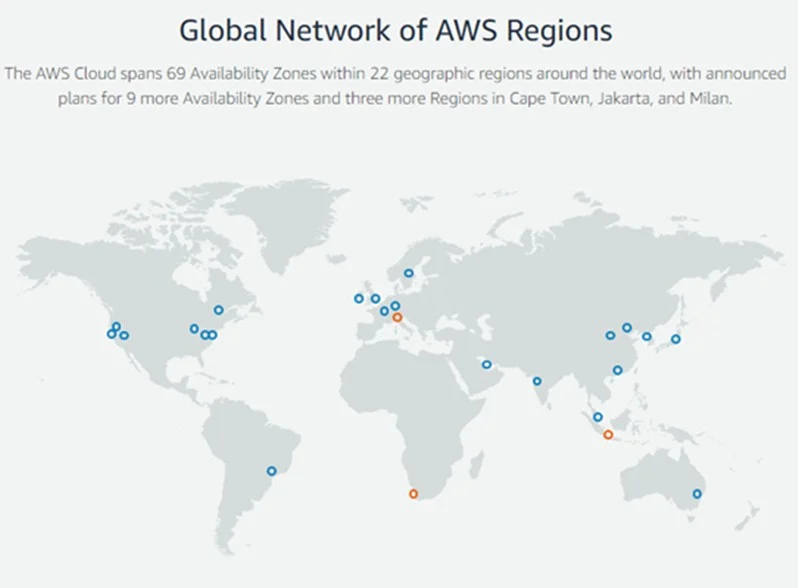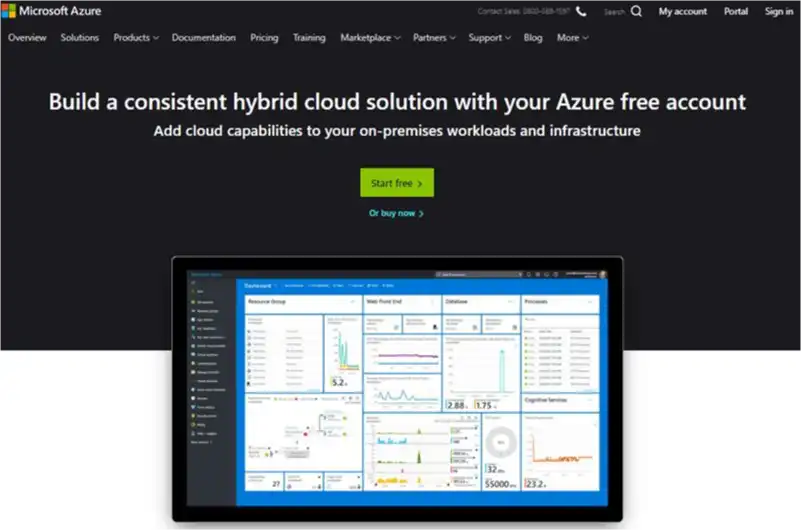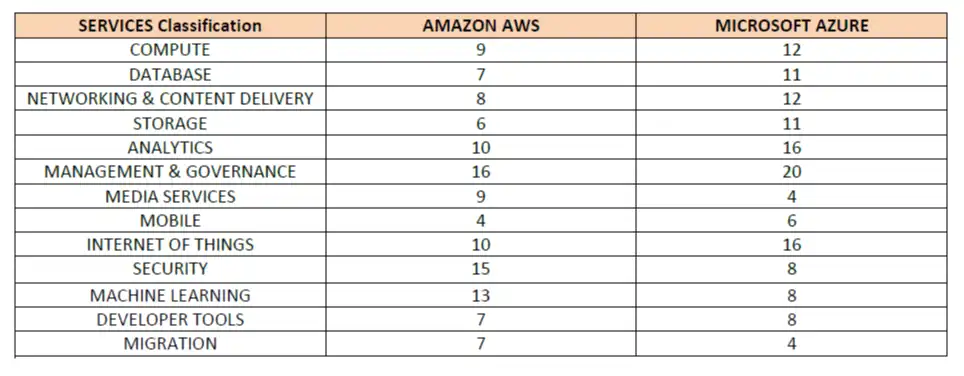Back to Blog
October 1, 2019
Juhi Gupta
en
AWS vs. Azure. Choose the one which suits your needs the best
Cloud Computing

Are you trying to decide on whether to go with AWS or Microsoft Azure?
First, you want to know that both platforms are incomparable champions and leading cloud technology. But it’s becoming a tough race as both services are the cream of the crop in their unique ways.
However, AWS has an edge; it’s older than Azure, so the competition is stiff for the newcomer, Azure. Let’s compare these two platforms side by side.
AWS vs Azure
In 2006, AWS launched some services that are
- The Simple Storage Service (S3),
- Elastic Compute Cloud (EC2), and
- Simple Queue Service (SQS)
Amazon AWS also began offering IT infrastructure services to businesses, web infrastructure services, precisely.
As more companies shifted their business to the cloud, the need for a platform like AWS skyrocketed. AWS launched new services and became the giant provider of cloud platform services (here are some resources to help you navigate through cloud service providers).
Meanwhile, Microsoft Azure only came into the picture in 2010. According to a report from Cloud Market Share about AWS in 2019, Amazon AWS remains dominant in all quarters of the year.
Microsoft Azure remains in number two despite having the same key capabilities as AWS. The similarities between both platforms are evident in
a.Computing
b.Storage,
c.Networking, and
d.Pricing
Some of the other shared features of the two platforms include:
a.Identity Access Management services
b.Reliable Database
c.Prompt provisioning services, and
d.High availability within the regions.
Region Expansion Around the World
If we talk about regions, AWS exists in over 22 geographic regions, and they’re currently making efforts to expand to four more regions. At the moment, Amazon AWS is about expanding to Bahrain, Cape Town, Jakarta, and Milan.

But Azure has covered over 46 geographic regions across the globe, and they have plans to expand to eight more regions.

Availability Zones for Highly Available Applications
Azure defines Availability Zones as unique physical locations within an Azure region. Additionally, each of these zones has one or more data centers, and these centers are equipped with independent power, cooling, and networking facilities.
There are at least three separate zones in all enabled regions, and that's because they protect applications and data from data center failures.
However, Amazon defines Availability Zones as isolated locations inside a region; each region involves multiple availability zones. An added benefit to this isolation is that it provides higher availability for applications and it reduces failures.
AWS cloud spans 69 Availability Zones within 22 geographic regions around the world (Here's the perfect parcel of information to learn cloud computing). Furthermore, the company announced plans for 12 more Availability Zones.
Pricing Models Compared
AWS and Azure cloud services have pricing calculators to uncover the cost of their services. As for AWS, it offers a pay as you go services and charge users per hour. And they round up the minutes you use to a full hour.
Pricing for Amazon AWS
Here’s a full breakdown of the pricing for AWS:
1. On-demand - The user can purchase and run an instance and pay for the resources used per hour.
2. Reserved - The resources are reserved with the user for a period, and this arrangement could be a one-year or three-year subscription plan. Once purchased, AWS permits you to use it in this capacity based on your subscription plan.
3. Spot - This price is for spare or unused capacity, if available. If your bid is higher than Amazon EC2’s stated price, you will get the resources running.
Pricing for Microsoft Azure
Azure also offers you pay-as-you-go services but charges per minute. According to available reports, this pricing plan is more accurate.
The pricing in Azure is as follows:
1. Reservation: This pricing plan allows you to pay less for select Azure services. All you have to do is forecast your resource needs and then make a one-year or three-year commitment.
2. Dev/Test Environment Workloads: You get suitable discounts for Dev/Test Environment Workloads.
So, from the above details, you can conclude that Azure is more accurate with its pricing, and it’s slightly cost-friendlier than AWS too.
Hybrid Cloud Seems to Be More Open with Azure

Azure offers significant support for hybrid clouds. Consequently, you can use your onsite server to run your applications in the Azure Stack; they may have seen this need long before AWS realized it.
Furthermore, several Azure offerings help you maintain and manage hybrid clouds.
These offerings include
a. Azure Stack
b. Hybrid SQL Server
c. Azure StorSimple.
Amazon realizes that it needs to strengthen its offerings to support hybrid clouds, but it is still catching up.
AWS - Highly Available and Durable Storage Services
AWS offers long-running and reliable storage services. Its services include:
1. AWS S3,
2. EBS, and
3. Glacier
Whereas Azure Storage services include
1. Blob Storage,
2. Disk Storage, and
3. Standard Archive
AWS S3 ensures high availability and automatic replication across regions. And it's more capable than the storage services offered by Azure.
Database Features
AWS provides the ability to implement a database in both SQL and NoSQL solutions.
1. The platform uses
2. Relational database service RDS for NoSQL.
3. For unstructured data, it uses DynamoDB, and
4. For data analytics, it uses Redshift.
5. Elastic Cache for data.
But Azure uses:
1. MySQL and PostgreSQL for the relational database
2. Cosmos DB for NoSQL data, and
3. Redis Cache for caching purposes
How Secure these Cloud Services Are
Let’s begin it with the number one champ, AWS.
AWS protects customer privacy. It keeps your data safe by storing it in highly secure data centers.
This platform manages dozens of compliance programs, such as;
1. PCI-DSS
2. HIPAA/HITECH
3. EU Data Protection Directive, and
4. FISMA to meet regulatory requirements
AWS allows you to block public access to all your objects at a bucket or account level. It achieves this with S3 block public access. AWS also supports auditing to track access requests made to your S3 resources.
Network firewalls built into Amazon VPC control access to your instances and applications.
But Azure protects your application and instances from common web vulnerabilities, it does this using a built-in web application firewall through Application Gateway.
Azure has a feature called Secure Score, which assesses your security posture. It's also compliant with regulatory requirements such as CIS, PCI-DSS, SOC, and ISO. Additionally, the security center has the ability to both detect and help protect you against threats.
Microsoft Azure supports DDoS attack protection. It scrubs the traffic at the Azure network edge, so it stops it before it can impact the availability of your service.
AWS Server Capacity Still Leads
AWS is the big brother of Azure. And the server capacity of AWS is much more than Azure. As of September 2019, Amazon AWS was offering a total of 145 services.
Specifically, these services include
1. Computing
2. Storage
3. Database
4. Migration and Transfer
5. Networking and Content delivery
6. Developer tools
7. Robotics
8. Blockchain
9. Satellite
10. Management and Governance
More so, Azure has the same offers as AWS. Let’s go deep into the type of services that both vendors offer. Below is a table that shows some notable service classes and the number of services they offer.

To Wrap Up
These cloud services are both masters at what they do. However, your choice will depend on your specific needs.
Azure has remained second best despite offering the same basic capabilities as AWS. However, the platform has covered more geographical regions than AWS. Additionally, their plan to add eight more regions is also twice as much as AWS’s expansion plans.
Secondly, Azure provides a better pricing model than AWS as it keeps a per-minute billing plan, whereas AWS bills per hour.
Furthermore, Azure is open to hybrid cloud services, but AWS offers more storage and durable services. In short, AWS service offerings for IAAS are better than Azure. However, Azure's service offerings for PAAS play better than AWS’s offerings.